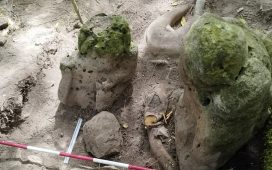Just over a century ago, celebrated Egyptologist Howard Carter broke open the seal on a tomb in the Valley of the Kings, near modern-day Luxor, and discovered a uniquely near-intact royal burial from ancient Egypt.
Within that tomb lay the mummified city of Tutankhamun, a young king of Egypt who died unexpectedly, aged about 18. He’s believed to have died from the complications of a broken leg while suffering from malaria.
Sensational new DNA analysis also suggests he would have suffered multiple health issues as a result of his parents being closely related. Now – some 3,300 years after he was laid to rest – the face of the tragic boy king has been brought back to life through AI.
Tutankhamun’s iconic golden burial mask conveys an image of perfection, but the truth is rather less impressive.
Experts believe that Tutankhamun would have stood around 5’6″ tall, with a slim build, a slightly longer-than-normal skull and unusually prominent front teeth. These new images draw on these features, emphasising the long-dead Egyptian monarch’s distinctive feaures.
We asked AI imaging software Midjourney to depict what Tutankhamun would have looked like in life, with a youthful glow to his complexion despite his chronic ill-health. The programme was also asked to create an image based off the Tut’s parent’s being related – thus risking the chances of birth defects.
He is also depicted as wearing earrings, after studies of his body found he had his ears pierced. The prominent front teeth and weak, receding chin still visible in his mummified body today are shown as they might have appeared in life.
Tutankhamun is thought to have suffered from a range of infirmities, probably because his parents were brother and sister.
Geneticist Dr Yehia Gad, one of the key researchers, explained that a DNA test on the young king’s remains revealed the shocking truth: “They turned out that they’re brother and sister, which was a big surprise for us.
“A lot of incest happened… they didn’t like to let royal and non-royal blood mix, so they tried to keep it within the royal family.”
Some experts believe he may have had gynecomastia – enlarged breasts, as well as girlish hips. But over the past 3,000 or so years the body’s tissue has become shrunken and distorted as it dried out over time – making an absolute determination difficult.
Initial reports of Tutankhamun’s cause of death suggest that he was either murdered, or died in a chariot race accident. But recent scans of the mummified body suggest that he may have died from an inherited illness.
Only one of his broken bones appears to have been sustained before he died, and he had a club foot would have almost certainly made chariot racing impossible. Over 100 walking sticks were found among the king’s possessions, underlining the theory that he would have walked with a limp.
While there’s a school of thought that the Egyptians of that era would have been very dark-skinned, anthropologist Nina Jablonski says that most of them were more likely to have an olive or coffee-coloured complexion.
“Our best guess is that he was neither lily white nor ebony black. He was probably somewhere in between,” she told NPR.
She added: “When we look at the representation of the Egyptian royalty on the walls of tombs, we see a range of sort of moderate, tan-coloured skin on the royalty. This probably is a fairly close approximation of what skin colour these people actually had.”











